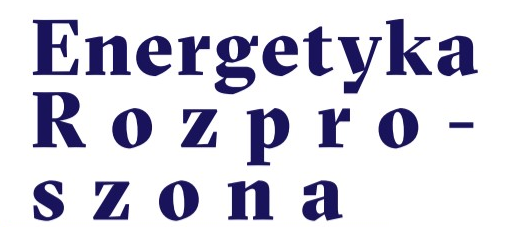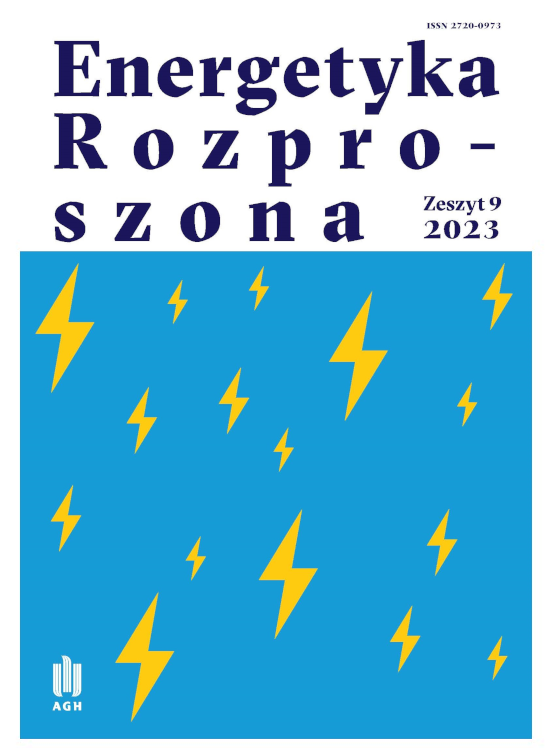Model DPSIR jako narzędzie efektywnego zarządzania jakością powietrza
DOI:
https://doi.org/10.7494/er.2023.9.35Słowa kluczowe:
jakość powietrza, polityka energetyczna, model DPSIR, modelowanie, pomiaryAbstrakt
Decyzje i działania (odpowiedzi) podejmowane na podstawie pełnej i wiarygodnej analizy czynników sprawczych, presji, zmiany parametrów stanu i ich wpływu na środowisko, społeczeństwo oraz gospodarkę mogą z dużym prawdopodobieństwem w długoterminowej perspektywie przynieść pożądane efekty. W artykule opisano model DPSIR (driving forces, pressures, state, impact, responses; odpowiednio: czynniki sprawcze, presje, stan, wpływ, odpowiedzi) służący do szczegółowej analizy interakcji pomiędzy czynnikami antropogenicznymi a środowiskiem. Tworzony model DPSIR będzie skutecznym narzędziem do zarządzania jakością powietrza. W artykule przedstawiono badania prowadzone w Akademii Górniczo-Hutniczej, które zostaną wykorzystane jako jedne z wielu danych wejściowych w powstającym modelu DPSIR. Opracowywany model będzie jednym ze składowych zaawansowanego narzędzia tworzonego na AGH, w ramach Obserwatorium Transformacji Energetycznej (OTE), które umożliwi przygotowanie rekomendacji optymalnych działań dotyczących realizacji polityki energetycznej i poprawy jakości powietrza w Polsce.
Bibliografia
Adamiec E., Jarosz-Krzemińska E. (2022), Korzyści środowiskowe i zdrowotne jako efekt realizacji polityki klimatycznej i rozwoju energetyki rozproszonej, „Energetyka Rozproszona” 8: 61–67.
Brzoza-Woch R., Pełech-Pilichowski T., Rudnicka A., Dajda J., Adamiec E., Jarosz-Krzemińska E., Kisiel-Dorohinicki M. (2022), Acquisition, Storing, and Processing System for Interdisciplinary Research in Earth Sciences, Computational Science – ICCS 2022: 22nd International Conference, London, Springer International Publishing: 422–435.
CAFE (2008), Dyrektywa Parlamentu Europejskiego i Rady 2008/50/WE z dnia 21 maja 2008 r. w sprawie jakości powietrza i czystszego powietrza dla Europy.
Carnohan S., Trier X., Liu S., Clausen L.P.W., Clifford-Holmes J.K., Hansen S.F., Benini L., McKnight U.S. (2023), Next Generation Application of DPSIR for Sustainable Policy Implementation, „Current Research in Environmental Sustainability” 5: 1–9.
Carr E.R., Wingard P.M., Yorty S.C., Thompson M.C., Jensen N.K., Roberson J. (2007), Applying DPSIR to sustainable development, „International Journal of Sustainable Development & World Ecology” 14: 543–555.
EEA (2022a), Air Quality in Europe 2022, https://www.eea.europa. eu/publications/air-quality-in-europe-2022 [dostęp: 3.03. 2022].
EEA (2022b), Air Quality Statistics. Key Air Quality Statistics for the Main Air Pollutants, https://www.eea.europa.eu/data-and-maps/ dashboards/air-quality-statistics [dostęp: 3.03.2022].
EEA (2022c), Health Impacts of Air Pollution in Europe 2022, https:// www.eea.europa.eu/publications/air-quality-in-europe-2022/ health-impacts-of-air-pollution [dostęp: 21.03.2022].
Elliott M. (2002), The Role of the DPSIR Approach and Conceptual Models in Marine Environmental Management: An Example for Offshore Wind Power, „Marine Pollution Bulletin” 44 (6): 3–7.
Eurostat (2022), Goods Transported by Type of Transport (Detailed Reporting Only), https://ec.europa.eu/eurostat/databrowser/ view/RAIL_GO_TYPEPAS__custom_3599985/default/table? lang=en [dostęp: 15.02.2022].
Eurostat (2023), Energy Balances, https://ec.europa.eu/eurostat/ data/database [dostęp: 15.02.2022].
Federigi I., Balestri E., Castelli A., De Battisti D., Maltagliati F., Menicagli V., Verani M., Lardicci C., Carducci A. (2022), Beach Pollution from Marine Litter: Analysis with the DPSIR Framework (Driver, Pressure, State, Impact, Response) in Tuscany, Italy, „Ecological Indicators” 143: 109395.
Gao L., Ning J., Bao W., Yan A., Yin Q. (2022), A Study on the Marine Ecological Security Assessment of Guangdong-Hong Kong-Macao Great Bay Area, „Marine Pollution Bulletin” 176: 113416.
Hou F.-M., Wang Y., Zuo F.-Y. (2019), Environmental Study on the Social and Economic Impact of Beijing’s Haze Problem: Based on DPSIR Model, „Ekoloji” 28 (107): 1299–1307.
Izar G.M., Choueri R.B., Martinez S.T., da Rocha G.O., Albergaria- -Barbosa A.C.R. (2022), The Application of the DAPSI(W)R(M) Framework to the Plastic Pellets Chain, „Marine Pollution Bulletin” 180: 113807.
Jain S., Sharma T., Gupta A.K. (2022), End-of-Life Management of Solar PV Waste in India: Situation Analysis and Proposed Policy Framework, „Renewable and Sustainable Energy Reviews” 153: 111774.
Jol A., Kielland G. (1997), Air Pollution in Europe 1997, EEA European Environment Agency, Copenhagen.
Kelble C.R., Loomis D.K., Lovelace S., Nuttle W.K., Ortner P.B., Fletcher P., Cook G.S., Lorenz J.J., Boyer J.N. (2013), The EBM- -DPSER Conceptual Model: Integrating Ecosystem Services into the DPSIR Framework, „PLoS ONe” 8 (8): e70766.
Kim Y.-S., Rodrigues M., Robinne F.-N. (2021), Economic Drivers of Global Fire Activity: A Critical Review Using the DPSIR Framework, „Forest Policy and Economics” 131: 102563.
KOBIZE, MKiŚ (2022), Krajowy bilans emisji SO2 , NOX, CO, NH3 , NMLZO, pyłów, metali ciężkich i TZO za lata 1990–2020. Raport syntetyczny, Warszawa.
Kristensen P. (2004), The DPSIR Framework, UNEP Headquarters, Nairobi.
Ladi T., Mahmoudpour A., Sharifi A. (2022), Assessing Environmental Impacts of Transportation Sector by Integrating DPSIR Framework and X-Matrix, „Case Studies on Transport Policy” 10 (1): 434–443.
Lange M., Burkhard B., Garthe S., Gee K., Kannen A., Lenhart H., Windhorst W. (2010), Analysing Coastal and Marine Changes – Offshore Wind Farming as a Case Study, Land-Ocean Interactions in the Coastal Zone (LOICZ), Geesthacht.
Li X., Zhan J., Lv T., Wang S., Pan F. (2023), Comprehensive Evaluation Model of the Urban Low-carbon Passenger Transportation Structure Based on DPSIR, „Ecological Indicators” 146: 109849.
Mohammadizadeh M.J., Karbassi A.R., Nabi Bidhendi G.R., Abbaspour M. (2016), Integrated Environmental Management Model of Air Pollution Control by Hybrid Model of DPSIR and FAHP, „Global Journal of Environmental Science and Management” 2 (4): 381–388.
OECD (1994), Environmental Indicators, Core Set. Organization for Economic Co-operation and Development, Paris.
Oleniacz R., Rzeszutek M. (2018), Intercomparison of the CALMET/ CALPUFF Modeling System for Selected Horizontal Grid Resolutions at a Local Scale: A Case Study of the MSWI Plant in Krakow, Poland, „Applied Sciences” 8 (11): 2301.
Oleniacz R., Bogacki M., Rzeszutek M., Kot A. (2014), Meteorologiczne determinanty jakości powietrza w Krakowie, [w:] Ochrona Powietrza w Teorii i Praktyce, t. 2, J. Konieczyński (red.), Instytut Podstaw Inżynierii Środowiska PAN w Zabrzu, Zabrze: 163–178.
Qu S., Hu S., Li W., Wang H., Zhang Ch., Li Q. (2020), Interaction between Urban Land Expansion and Land Use Policy: An Analysis Using the DPSIR Framework, „Land Use Policy” 99: 104856.
Quevedo J.M.D., Uchiyama Y., Kohsaka R. (2023), A Blue Carbon Ecosystems Qualitative Assessment Applying The DPSIR Framework: Local Perspective of Global Benefits and Contributions, „Marine Policy” 128: 104462.
Reich R.H., Vermeyen V., Alaerts L., Acker K.V. (2022), How to Measure a Circular Economy: A Holistic Method Compiling Policy Monitors, „Resources, Conservation and Recycling” 188: 106707.
Relvas H., Miranda A.I. (2018), Application of the DPSIR Framework to Air Quality Approaches, „Air Quality, Atmosphere & Health” 11: 1069–1079.
Rozporządzenie Ministra Środowiska z dnia 14 czerwca 2019 r. w sprawie programów ochrony powietrza oraz planów działań krótkoterminowych (Dz.U. 2019 poz. 1159).
Rzeszutek M., Bogacki M. (2016), Ocena modelu dyspersji zanieczyszczeń powietrza OSPM: studium przypadku, „Rocznik Ochrona Środowiska” 18 (2): 351–362.
Rzeszutek M., Szulecka A., Oleniacz R., Bogacki M. (2017), Assessment of the AERMOD Dispersion Model over Complex Terrain with Different Types of Meteorological Data: Tracy Power Plant Experiment, „E3S Web of Conferences” 22: 00149.
Salim H., Jackson M., Stewart R.A., Beal C.D. (2023), Drivers-pressuresstate-impact-response of Solid Waste Management in Remote Communities: A Systematic and Critical Review, „Cleaner Waste Systems” 4: 100078.
von Schirnding Y.E. (2002), Health-and-environment Indicators in the Context of Sustainable Development, „Canadian Journal of Public Health” 93: 9–15.
Sheoran M., Kumar P., Sharma S., Bukya M. (2022), Current Situation Analysis of Solar PV Waste Management in India, „Materials Today: Proceedings” 58 (2): 773–782.
Su Y., Fan Q. (2022), Renewable energy Technology Innovation, Industrial Structure Upgrading and Green Development From the Perspective of China’s Provinces, „Technological Forecasting and Social Change” 180: 121727.
Tesfaldet Y.T., Ndeh N.T. (2022), Assessing Face Masks in the Environment by Means of the DPSIR Framework, „Science of the Total Environment” 814: 152859.
WHO (2021), WHO Global Air Quality Guidelines: Particulate Matter (PM2.5 and PM10), Ozone, Nitrogen Dioxide, Sulfur Dioxide and Carbon Monoxide: Executive Summary, WHO European Centre for Environment and Health, Bonn.
Xiao Y., Chen J., Wang X., Lu X. (2022), Regional Green Development Level and It’s Spatial Spillover Effects: Empirical Evidence from Hubei Province, China, „Ecological Indicators” 143: 109312.
Yang B., Ding L., Zhan X., Tao X., Peng F. (2022), Evaluation and Analysis of Energy Security in China Based on the DPSIR Model, „Energy Reports” 8 (4): 607–615.
Zyśk J., Wyrwa A., Suwała W., Pluta M., Olkuski T., Raczyński M. (2020), The Impact of Decarbonization Scenarios on Air Quality and Human Health in Poland – Analysis of Scenarios up to 2050, „Atmosphere” 11 (11): 1222.
Zyśk J., Wyrwa A., Pluta M., Olkuski T., Suwała W., Raczyński M. (2021), The Health Impact and External Cost of Electricity Production, „Energies” 14 (24): 8263.
Pobrania
Opublikowane
Numer
Dział
Licencja
Prawa autorskie (c) 2023 Czasopismo „Energetyka Rozproszona” stosuje licencję „Creative Commons Uznanie autorstwa 4.0”, która pozwala na kopiowanie, zmienianie, rozprowadzanie, przedstawianie i wykonywanie utworu jedynie pod warunkiem oznaczenia autorstwa. Z pełną treścią licencji można zapoznać się na stronie: https://creativecommons.org/licenses/by/4.0/legalcode.

Utwór dostępny jest na licencji Creative Commons Uznanie autorstwa 4.0 Międzynarodowe.


